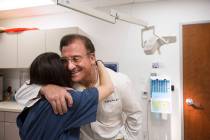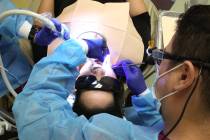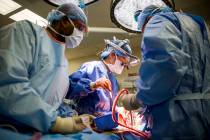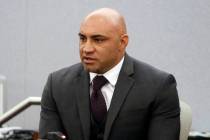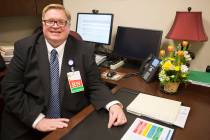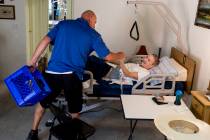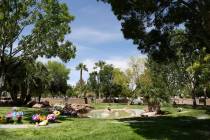Tumor patient not giving up
What 18-year-old Leah Goldberg was going through — trying to overcome the deadliest brain cancer known to man — hit 60-year-old retired Army Lt. Col. Todd Sain hard.
After my May 31 piece that described how a gioblastoma multiforme tumor had the senior at Northwest Career and Technical Academy fighting for her life at Sunrise Hospital and Medical Center, Sain made sure he attended a fundraiser in early June that saw all proceeds donated to the Goldberg family.
“I hate to see someone so young having to struggle with this — it typically affects older people,” Sain said later. “I don’t know her or her family but people going through this need all the support they can get.”
He should know. He was diagnosed with the same kind of tumor — its median survival rate is between 12 and 15 months — last December.
“You can really be put in a funk when you receive the diagnosis,” he said as he sat with his wife, Vicky, in the living room of their home not far from Palace Station. “You’re in such a state of shock. It’s just awful.”
I told Sain what I recently learned from Leah’s oncologist: She couldn’t leave the hospital for her June 12 high school graduation because “her care is just too intense right now.” Sain closed his eyes for a long time before he spoke.
“And to think,” he said, “that you wrote she had an MRI in March which showed her tumor wasn’t growing, appeared to be gone. This just shows how fast things can change.”
“You find,” said Vicky Sain, also a retired Army lieutenant colonel, “that you begin to live MRI to MRI.”
Sain and his wife own and operate two Huntington Learning Center franchises in the Las Vegas Valley. In November, Sain’s life couldn’t have changed faster if he had ordered it.
In anticipation of a visit by his brother, the health-conscious Sain, who swam several laps for exercise that morning, was at a hotel making a reservation for him when he felt like “somebody stuck a Novocain needle” in his tongue.
“All of a sudden I couldn’t talk,” he said.
Thinking he could get home and rest, he wasn’t even able to drive a mile before he had to pull off the road. He managed to talk well enough — “I was speaking so slowly, like I had a stroke” — to call both 911 and his wife, who would meet the ambulance that carried her husband to the Summerlin Hospital emergency room.
A CAT scan showed he had a brain tumor. He was transferred to Spring Valley Hospital. Further tests there would show that the tumor was lodged near that part of the brain that controlled, among other things, speech.
A doctor told the Sains, who have two grown sons, that in her opinion his tumor was inoperable. They were also told that UCLA might offer some hope. That’s where surgeons removed as much of Leah’s tumor as possible two years ago.
Depressed and without family support in Los Angeles, the Sains decided to travel to Florida, where they had extended family. A biopsy taken of his tumor at an Orlando hospital in December found he had the GBM tumor. A surgeon there also called the tumor inoperable.
“Vicky and I were in such a funk,” said Sain, who at that time thought he was “finished.”
But then he started seriously using the Internet, finding a website, virtualtrials.com, that details clinical trials and research findings about GBMs. Contacts were made through the National Brain Tumor Society and the American Brain Tumor Association.
He started learning about people who have not only survived, but had an excellent quality of life for more than 10 years while living with a GBM.
“We decided I wasn’t going to go down without a fight,” Sain said as his wife nodded.
During his networking with GBM survivors, he heard about Dr. Mitchel Berger, the chair of neurological surgery at the University of California, San Francisco Medical Center and a pioneer of new tumor treatments. Sain made an appointment for a consultation with the surgeon in early January.
In mid-January Berger removed much of Sain’s tumor.
“Before he had the surgery, Dr. Berger said it might be months before Todd talked again, but he was speaking again right after the surgery,” Vicky Sain recalled.
Sain received the chemotherapy and radiation required after surgery while near family in Orlando. When that ended, the Sains returned to Las Vegas in March. Having found a clinical trial for a vaccine that could stop tumor progression, Sain travels back and forth to San Francisco twice a mouth to participate.
What he wants to do now is start a support group in Las Vegas for people diagnosed with brain tumors. He is working with the American Brain Tumor Association to do so.
“Vicky and I were part of a fundraising walk in San Franciso in May and we both wondered why this wasn’t being done in Las Vegas,” he said. “We should be doing fundraising for research right here — research that could prevent people like Leah Goldberg from going through what she is today.”
Sain and his wife want to be able to give people as much information about what to do when given a brain tumor diagnosis. “People have to know where to get second opinions, how to get in the right trials,” he said. “When you’re in shock and all alone, it is difficult to know which way to turn.”
No one knows at this time how many people suffer from brain tumors in Las Vegas. The incidence of GBMs alone is between 2 and 3 per 100,000 people. Sain said he’d like to hear from as many survivors as possible at toddsain@cox.net.
“We can learn from each other,” he said. “I’m staying in touch now with people who’ve had GBMs for years, learning what to do. I don’t think these tumors have to be the death sentence the statistics make everyone try to believe.”
Contact reporter Paul Harasim at pharasim@reviewjournal.com or 702-387-2908.



